Battle of Mobile Bay facts for kids
Quick facts for kids Battle of Mobile Bay |
|||||||
|---|---|---|---|---|---|---|---|
| Part of the American Civil War | |||||||
 Battle of Mobile Bay, by Louis Prang. At left foreground is the CSS Tennessee; at the right the USS Tecumseh is sinking. |
|||||||
|
|||||||
| Belligerents | |||||||
| Commanders and leaders | |||||||
| Strength | |||||||
|
|||||||
| Casualties and losses | |||||||
|
|
||||||
The Battle of Mobile Bay was a major fight during the American Civil War. It happened on August 5, 1864, in Mobile Bay, Alabama. This battle involved both ships and soldiers.
A Union (Northern) fleet, led by Admiral David Farragut, attacked a smaller Confederate (Southern) fleet. The Union forces also aimed to capture three forts guarding the bay's entrance. These forts were named Morgan, Gaines, and Powell.
The battle is famous for Admiral Farragut's bold move. He led his ships through a dangerous area filled with underwater mines. One of his ironclad ships, the USS Tecumseh, sank after hitting a mine. Despite this, Farragut's fleet pushed through. This allowed them to get past the shore guns.
After getting past the forts, the Union fleet faced the Confederate ships. The Confederate fleet was quickly defeated, leaving only one powerful ship: the ironclad CSS Tennessee.
The Tennessee did not give up. It bravely fought the entire Union fleet alone. Its strong armor protected it from many hits. However, it was greatly outnumbered. Eventually, the Tennessee was too damaged to move and had to surrender. This ended the naval part of the battle.
Without naval support, the three Confederate forts also surrendered within days. This meant the Union forces gained full control of lower Mobile Bay.
Why Was Mobile Bay Important?
Mobile was the last major port on the Gulf of Mexico still held by the Confederacy. Capturing it was a big step in the Union's plan to blockade Southern ports. A blockade stops supplies and trade from reaching the enemy.
This Union victory was a huge boost for the North. It happened around the same time as the capture of Atlanta. Newspapers widely reported both victories. These successes helped Abraham Lincoln win re-election as president three months later.
The Battle of Mobile Bay was the last naval battle in Alabama during the war. It was also Admiral Farragut's final major battle.
What Happened After the Battle?
The Battle of Mobile Bay was not as bloody as some land battles of the Civil War. But it was still a tough fight for ships. The Union fleet lost 150 sailors killed and 170 wounded. On the Confederate ships, 12 men died and 19 were wounded. Union soldiers fighting on land had very few losses.
The Union army stayed near Mobile after the battle. This kept Confederate soldiers busy defending the city. It stopped them from helping other Confederate forces elsewhere.
This was especially helpful for Union General William Tecumseh Sherman. At the time, Sherman was fighting in the Atlanta campaign. The victory at Mobile Bay helped the Union's overall war effort.
At first, people in the North didn't fully realize how important Farragut's victory was. But as more Union victories followed, the Battle of Mobile Bay became seen as a very significant win.
When Atlanta fell, historians later called the Mobile Bay victory "the first blow of a lethal one-two punch." These victories made people in the North feel more hopeful. This helped President Abraham Lincoln win his re-election. His re-election was seen as a vote to continue the war.
The Union forces now controlled the lower Mobile Bay. However, they did not attack the city of Mobile itself right away. The bay had a sandbar that stopped Farragut's large ships from going further up. Mobile was finally attacked and captured in March and April 1865. This happened near the very end of the war.
Many shipwrecks from the battle are still in Mobile Bay today. These include the USS Tecumseh and the CSS Tennessee.
Images for kids
See also
 In Spanish: Batalla de la bahía de Mobile para niños
In Spanish: Batalla de la bahía de Mobile para niños


